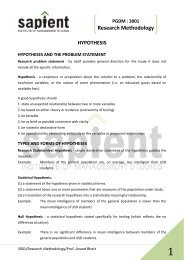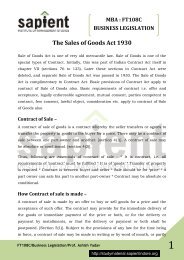Consumer Decision Process
Consumer Decision Process
Consumer Decision Process
Create successful ePaper yourself
Turn your PDF publications into a flip-book with our unique Google optimized e-Paper software.
Module 2<br />
Chapter 2<br />
FT‐405M<br />
<strong>Consumer</strong> Behavior<br />
and Rural Marketing<br />
<strong>Consumer</strong> <strong>Decision</strong> <strong>Process</strong>es, Pre‐purchase process: Information processing, Purchase<br />
<strong>Process</strong>es: <strong>Consumer</strong> <strong>Decision</strong> rules. Post Purchase processes: Framework, dissonance<br />
satisfaction / dissatisfaction.<br />
Traditionally, consumer researchers have approached decision making process from a rational<br />
perspective. This dominant school of thought views consumers as being cognitive (i.e., problem‐<br />
solving) and, to some but a lesser degree, emotional. i Such a view is reflected in the stage model<br />
of a typical buying process (often called the consumer information processing model) depicted in<br />
Figure 1.<br />
Problem Recognition<br />
Information Search<br />
Evaluation and Selection of Alternatives<br />
<strong>Decision</strong> Implementation<br />
Postpurchase Evaluation<br />
Figure 1 : The <strong>Consumer</strong> Information <strong>Process</strong>ing Model<br />
Source: Adopted from Kotler (1997), Schiffman and Kanuk (1997), and Solomon (1996)<br />
In this model, the consumer passes through five stages: problem recognition, information search,<br />
evaluation and selection of alternatives, decision implementation, and post‐purchase evaluation.<br />
1<br />
FT‐405M/<strong>Consumer</strong> Behavior and Rural Marketing/Prof. Arpit Loya
Problem Recognition<br />
FT‐405M<br />
<strong>Consumer</strong> Behavior<br />
and Rural Marketing<br />
In this information processing model, the consumer buying process begins when the buyer<br />
recognizes a problem or need. For example, Doug may realize that his best suit doesn’t look<br />
contemporary any more. Or, Kathleen may recognize that her personal computer is not<br />
performing as well as she thought it should. These are the kinds of problem that we as consumers<br />
encounter all the time. When we found out a difference between the actual state and a desired<br />
state, a problem is recognized. When we find a problem, we usually try to solve the problem.<br />
We, in other words, recognize the need to solve the problem. But how?<br />
Information Search<br />
When a consumer discovers a problem, he/she is likely to search for more information. Kathleen<br />
may simply pay more attention to product information of a personal computer. She becomes<br />
more attentive to computer ads, computers purchased by her friends, and peer conversations<br />
about computers. Or, she may more actively seek information by visiting stores, talking to friends,<br />
or reading computer magazines, among others. Through gathering information, the consumer<br />
learns more about some brands that compete in the market and their features and characteristics.<br />
Theoretically, there is a total set of brands available to Kathleen, but she will become aware of<br />
only a subset of the brands (awareness set) in the market. Some of these brands may satisfy her<br />
initial buying criteria, such as price and processing speed (consideration set).<br />
As Kathleen<br />
proceeds to more information search, only a few will remain as strong candidates (choice set).<br />
Evaluation and Selection of Alternatives<br />
How does the consumer process competitive brand information and evaluate the value of the<br />
brands? Unfortunately there is no single, simple evaluation process applied by all consumers or<br />
by one consumer in all buying situations.<br />
One dominant view, however, is to see the evaluation process as being cognitively driven and<br />
rational. Under this view, a consumer is trying to solve the problem and ultimately satisfying<br />
his/her need. In other words, he/she will look for problem‐solving benefits from the product. The<br />
consumer, then, looks for products with a certain set of attributes that deliver the benefits. Thus,<br />
the consumer sees each product as a bundle of attributes with different levels of ability of<br />
delivering the problem solving benefits to satisfy his/her need. The distinctions among the need,<br />
benefits, and attributes are very important. One useful way to organize the relationships among<br />
FT‐405M/<strong>Consumer</strong> Behavior and Rural Marketing/Prof. Arpit Loya 2
FT‐405M<br />
<strong>Consumer</strong> Behavior<br />
and Rural Marketing<br />
the three is a hierarchical one (Figure 2). Although simplified, Figure 2 is an example of how a<br />
bundle of attributes (i.e., a product or, more specifically, personal computer) relates to the<br />
benefits and underlying needs of Kathleen.<br />
Underlying Needs<br />
Helps Me Survive<br />
Babson MBA Pogram<br />
Benefits<br />
Portability<br />
Doesn’t Break<br />
down<br />
Economy<br />
Computational<br />
Horse Power<br />
Warranty<br />
Attributes<br />
Size<br />
Brand<br />
Reputation<br />
Price<br />
Software<br />
Bundle<br />
CPU Speed<br />
GlobeNet<br />
Ready<br />
Hard Drive Size<br />
Figure 2 : Hierarchical View of Needs, Benefits, and Attributes<br />
From this figure and the preceding discussion, you might recognize that the product attributes are<br />
relevant and important only to the extent that they lead to a certain set of benefits. Likewise,<br />
benefits are meaningful only if they can address the problem and be instrumental to satisfy the<br />
underlying need. As the underlying need is often personal, consumers differ as to their beliefs<br />
about what product benefits and attributes are more (or less) important and relevant in satisfying<br />
their needs. Based on their personal judgment on importance of benefits and attributes,<br />
consumers develop a set of attitudes (or preferences) toward the various brands. One may<br />
express his/her preferences of the brands in terms of ranking, probability of choice, and so forth.<br />
<strong>Decision</strong> Implementation<br />
To actually implement the purchase decision, however, a consumer needs to select both specific<br />
items (brands) and specific outlets (where to buy) to resolve the problems. There are, in fact,<br />
3<br />
FT‐405M/<strong>Consumer</strong> Behavior and Rural Marketing/Prof. Arpit Loya
FT‐405M<br />
<strong>Consumer</strong> Behavior<br />
and Rural Marketing<br />
three ways these decisions can be made: 1) simultaneously; 2) item first, outlet second; or 3)<br />
outlet first, item second. ii<br />
In many situations, consumers engage in a simultaneous selection<br />
process of stores iii and brands. For example, in our Kathleen’s personal computer case, she may<br />
select a set of brands based on both the product’s technical features (attributes) and availability<br />
of brands in the computer stores and mail‐order catalogs she knows well. It is also possible, that<br />
she decides where to buy (e.g., CompUSA in her neighborhood) and then chooses one or two<br />
brands the store carries. Once the brand and outlet have been decided, the consumer moves on<br />
to the transaction (“buying”).<br />
i<br />
See also Schiffman, Leon G. and Leslie Lazar Kanuk (1997), <strong>Consumer</strong> Behavior, Upper Saddle<br />
River, New Jersey: Prentice Hall. and Solomon, Michael R. (1996), <strong>Consumer</strong> Behavior: Buying,<br />
Having, and Being, Englewood Cliffs, New Jersey: Prentice Hall. For more detailed discussions and<br />
paper citations, refer to Engel, James F., Roger D. Blackwell, and Paul W. Minard (1993), <strong>Consumer</strong><br />
Behavior, 7 th ed., Fort Worth, Texas: Dryden Press. and Wilkie, William L. (1990), <strong>Consumer</strong><br />
Behavior, 2 nd ed., New York, New York: John Wiley & Sons.<br />
ii<br />
Hawkins, Del I., R. J. Best, and K. A. Coney (1983), <strong>Consumer</strong> Behavior: Implications for Marketing<br />
Strategy, Plano, Texas: Business Publications Inc.<br />
iii<br />
<strong>Consumer</strong>s may also consider non‐store shopping (internet web pages, catalogues, CUC<br />
International, etc.).<br />
FT‐405M/<strong>Consumer</strong> Behavior and Rural Marketing/Prof. Arpit Loya 4








